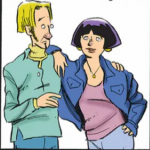Key defense crash expert refutes vehicle strike in Karen Read case
Published in News & Features
DEDHAM, Mass. — A key Karen Read defense crash reconstruction expert testified that damage to her SUV — the alleged murder weapon — and wounds to boyfriend John O’Keefe’s arm are “inconsistent” with a vehicle strike.
Daniel Wolfe, a Ph.D. who serves as chief of the crash reconstruction unit of an engineering consultancy company called ARCCA, was asked Friday if he had concluded whether damage to the right taillight of Read’s Lexus LX570 SUV as well as wounds to victim O’Keefe’s right were consistent or not consistent with a rearward “high-speed impact maneuver.”
“It was inconsistent,” Wolfe said. He added that he came to this conclusion through his testing, which he walked the jury through during hours of direct examination, which “was based upon all generally accepted and peer-reviewed methodologies in the crash reconstruction community.”
Wolfe testified at Read’s first trial last year that all other factors and context notwithstanding, the facts of the vehicle and O’Keefe’s wounds do not suggest a vehicle strike. That is how the prosecution says Read killed O’Keefe, a Boston cop she had dated for roughly two years at the time of his death on Jan. 29, 2022. Read, 45, of Mansfield, faces charges including second-degree murder.
But what he testified to on Friday was based on new testing used to put the competing theories of the prosecution’s new crash reconstructionist, Judson Welcher of the engineering consultancy company Aperture, through the wringer. The scope of his testimony, and that of the upcoming testimony of his colleague Andrew Rentschler, was determined during pre-trial questioning of the witnesses.
Welcher was the prosecution’s final witness and when he took the stand over three days last week he testified that his analysis led him to the concussion that Read struck O’Keefe with her vehicle at around 12:32 a.m. that fateful night outside 34 Fairview Road in Canton.
Many of defense attorney Alan Jackson’s questions put a spotlight on supposed inadequacies in Welcher’s testing and methodologies.
While Welcher did do a test in which he painted the right taillight of an exemplar vehicle — meaning the same model year and type as Read’s SUV — and then had himself struck at roughly 2 mph to find where a vehicle may strike his arm, Wolfe testified that this sole test missed the mark for a thorough examination.
Jackson asked Wolfe if he saw any testing by Welcher that could determine the forces necessary to cause the damage seen to Read’s SUV’s taillight or to O’Keefe’s arm.
“Not that I’m aware of, no,” Wolfe said.
Jackson established that the defense paid ARCCA roughly $20,000 for their time and travel expenses in the first trial and about $50,000 for this new testing and expenses for the current trial. But he also established that the defense did not pay for the testing presented in the first round — that was paid for by an outside agency.
It’s another example of the euphemisms that the attorneys must use to refer to the shadowy federal probe into the investigation that led to Read’s arrest. While special prosecutor Hank Brennan said in March that the federal investigation “ is closed,” the attorneys are barred from directly mentioning it in court. So whenever evidence unearthed by the U.S. Attorney’s office or the FBI is used in court, it is always referred to obliquely.
During cross-examination, Brennan raised many of the concerns he had about the ARCCA witnesses during their pre-trial examination. He had asked that they only be able to testify to material presented by evidence deadlines and said that to allow testimony on the new testing would be a “trial by ambush.”
He couldn’t use such language in front of the jury but he did point out how late certain materials were presented: Wolfe filed his report in May and the PowerPoint presentation was provided on Wednesday.
But he also hammered away at possible inadequacies in Wolfe’s own testing.
Wolfe’s testing included vehicle strike simulations with ARCCA’s own exemplar Lexus against a crash test dummy arm. He tested the collision at various speed levels, which led to his conclusion that the damage to the car and O’Keefe’s arm precluded a vehicle strike. He also used a separate dummy, called a “Rescue Randy,” for a full-body test at higher-level speeds and for testing damage to the hooded sweatshirt O’Keefe was wearing.
Brennan had multiple concerns about this. For one, Wolfe’s testing involved a dummy arm that weighed 9.38 pounds when a 12 pound arm, which is much closer to the weight of O’Keefe’s real arm, was available and could have offered more accurate test results. For another, the fake arm wouldn’t attest to the abrasions and other wounds the prosecution says prove a strike.
And while Wolfe testified that the “crash dummy is a generally accepted test device to use for not only to assessing occupant forces in motor vehicle crashes but also to assess impact forces,” Brennan cast doubt on “Rescue Randy,” which isn’t designed to the same exacting forensic standards as true crash test dummies.
_____
©2025 MediaNews Group, Inc. Visit at bostonherald.com. Distributed by Tribune Content Agency, LLC.







Comments